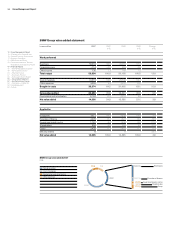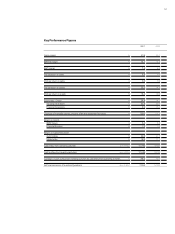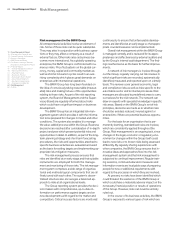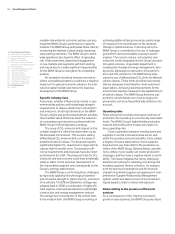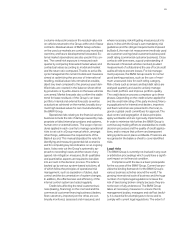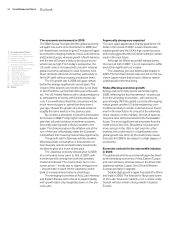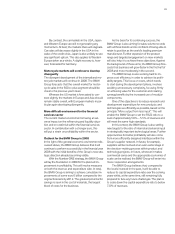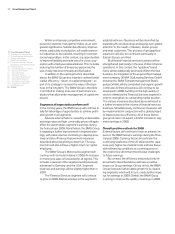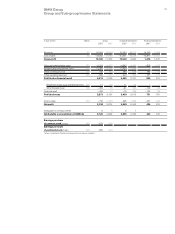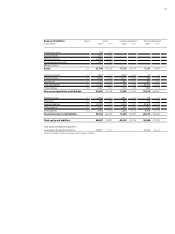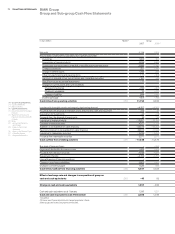BMW 2007 Annual Report Download - page 68
Download and view the complete annual report
Please find page 68 of the 2007 BMW annual report below. You can navigate through the pages in the report by either clicking on the pages listed below, or by using the keyword search tool below to find specific information within the annual report.66 Group Management Report
10 Group Management Report
10 A Review of the Financial Year
13 General Economic Environment
17 Review of Operations
41 BMW Stock and Bonds
44 Disclosures relating to Takeover
Regulations and Explanatory Report
47 Financial Analysis
47 – Internal Management System
49 – Earnings Performance
51 – Financial Position
52 – Net Assets Position
55 – Subsequent Events Report
55 – Value Added Statement
57 – Key Performance Figures
58 – Comments on BMW AG
62 Risk Management
68 Outlook
those legal regulations is set out in corporate guide-
lines and in the BMW Group’s stated set of core
principles. However, wrongdoing by individuals can
never be entirely ruled out. It is the BMW Group’s
objective to keep such risks to a minimum and to
systematically uncover any cases of corruption,
bribery or blackmail. The BMW Group set up a Com-
pliance Committee in 2007 which reports directly to,
and advises, the Board of Management of BMW AG.
Like all enterprises, the BMW Group is exposed
to the risk of warranty claims. Adequate provisions
have been recognised in the balance sheet to cover
such claims. Part of the risk, especially where the
American market is concerned, has been insured
externally up to economically acceptable levels. The
high quality of BMW Group products, additionally
ensured by regular quality audits and ongoing im-
provement measures, helps to reduce this risk. In
comparison with competitors, this can give rise to
benefits and opportunities for the BMW Group.
Changes in the regulatory environment may im-
pair the sales volume, revenues and earnings per-
formance of the BMW Group in individual markets
or economic regions. Further information is given in
the section on sector-specific risks.
Personnel risks
As an attractive employer, the BMW Group has found
itself in a favourable position for many years in the
in-
tense competition for qualified technical and manage-
ment
staff. Employee satisfaction and a low level of
employee fluctuation also help to minimise the risk
of know-how drift. The BMW Group’s attractiveness
as an employer also helps to ensure that appropri-
ately qualified staff can be recruited, particularly in
conjunction with the implementation of the Group’s
new strategy.
An ageing and shrinking population in Germany
will have a lasting impact on the conditions prevailing
in the labour, product, services and financial mar-
kets. Demographic change will give rise to risks and
opportunities which will affect enterprises more and
more in the coming years. The BMW Group sees
demographic change as one of its main challenges
and is actively involved in planning for its effect
on operations. The focus is on the following areas of
action, aimed at creating and retaining a motivated
workforce in the long-term:
(1) the creation of a working environment for the
future
(2) promotion and maintenance of the workforce’s
ability to perform with the appropriate set of skills
(3) appropriate levels of qualification
(4) increasing employees’ awareness of their re-
sponsibility to make personal provisions for their
future
(5) individual employee working life-time models
The BMW Group’s pension obligations to its em-
ployees resulting from defined benefit plans are
measured on the basis of actuarial reports. In accord-
ance with IAS 19, future pension payments are dis-
counted by reference to market yields on high-
quality corporate bonds. These yields are subject to
market fluctuation and influence the level of pension
obligations. Furthermore, changes in other factors,
such as longer life expectancies, can also have an
impact on pension obligations. In the United King-
dom, the USA and a number of other countries,
funds intended to cover pension entitlements are
held in pension funds which are kept separate from
corporate assets and are mainly invested in fixed-
income securities (with a high level of creditworthi-
ness), equities and property. In Germany, by contrast,
the funds remain part of the enterprise’s assets.
Risks affecting pension funds are monitored
continuously and managed from a risk and yield
perspective. Regular asset-liability studies are per-
formed and used to match the maturities of inter-
est-generating investments with future pension
payments, thereby reducing the interest rate risk
attached to each pension fund. Investments are
broadly spread in order to reduce risk. In addition,
risk limits for investment activities have been de-
fined for each pension fund and are monitored con-
tinuously.
Risk indicators (e.g. value-at-risk) are regularly
computed in order to identify risks at an early stage.
Risk mitigation measures are put into place as soon
as predefined risk limits are reached. Worst-case
analyses are also carried out regularly to assess the


